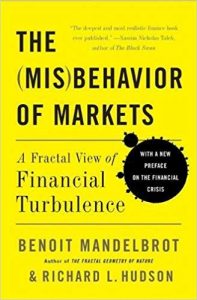Review The Misbehavior of Markets: A Fractal View of Financial Turbulence
by BENOIT MANDELBROT and RICHARD HUDSON
Description
Regarded as the Father of Fractal Geometry, Benoit Mandelbrot is a math genius who integrated his discovery into the financial sector that gave the world a new lens to view the financial industry. The (Mis) Behavior of Markets is a testament to the financial market’s performance and tendencies in relation to the fractal ideology.
Together with Richard Hudson, a science journalist, and editor at Wall Street, Mandelbrot takes us to the fractal world of finance and gives his take on the financial turbulence that occurred over the years. This material will also give researches an opportunity to take a closer look at fractals and explore financial behaviors that are yet to manifest.
About the Author
Benoit Mandelbrot is a professor of Mathematical Sciences at Yale University. He discovered fractal geometry and is a recipient of the Wolf Prize in Physics. Mandelbrot is a journalist, editor, and writer of several books and articles. He worked at Wall Street and served as its managing editor for more than two decades.
Richard L. Hudson co-authored the book The Misbehavior of Markets: A Fractal View of Financial Turbulence. He previously worked as Wall Street Journal’s managing editor for six years and Journal editor for two and a half decades.
Table of Contents
This book contains these topics:
PART ONE – The Old Way
CHAPTER I – Risk, Ruin, and Reward
“Modern” financial theory is founded on a few, shaky myths that lead us to underestimate the real risk of financial markets.
CHAPTER II – By the Toss of a Coin or the Flight of an Arrow?
How the operations of mere chance can be used to study a financial market.
CHAPTER III – Bachelier and His Legacy
The study of financial theory began a century ago with a brilliant but undervalued French mathematician, Louis Bachelier.
CHAPTER IV – The House of Modern Finance
How the edifice of modern financial theory – valuing assets, building portfolios and assessing risk – was erected on Bachelier’s work.
CHAPTER V – The Case Against the Modern
Theory of Finance
Pictorial Essay: Images of the Abnormal
PART TWO – The New Way
CHAPTER VI – Turbulent Markets: A Preview
Financial markets are turbulent – like the wind or the flood. An introduction to the fractal view of finance.
CHAPTER VII – Studies in Roughness: A Fractal Primer
Pictorial Essay: A Fractal Gallery
CHAPTER VIII – The Mystery of Cotton
Clue No. 1: A Power Law Out of the Blue
Clue No. 2: Early Power Laws in Economics
Clue No. 3: The Laws of Exceptional Chance
CHAPTER IX – Long Memory, from the Nile to the Marketplace
The second clue to fractal finance came from lifelong study of the Nile River by an English hydrologist, H.E. Hurst
CHAPTER X – Noah, Joseph, and Market Bubbles
The two critical features of financial markets are wild price swings and long-term dependence – the Noah Effect and the Joseph Effect.
CHAPTER XI – The Multifractal Nature of Trading Time
PART THREE – The Way Ahead
CHAPTER XII – Ten Heresies of Finance
How do financial markets really work? A list of key insights provided by the fractal view of finance.
CHAPTER XIII – In the Lab
So how can the study of fractals changes finance? A program for future research.
